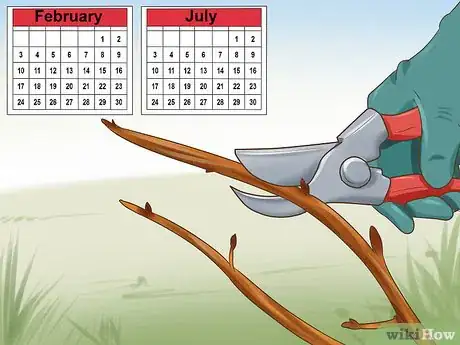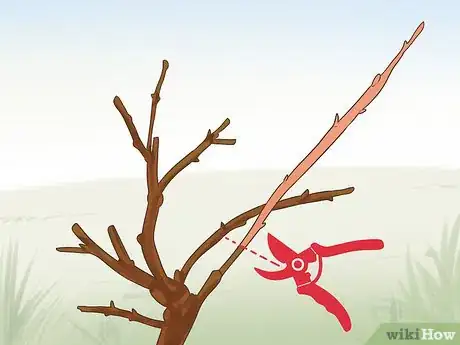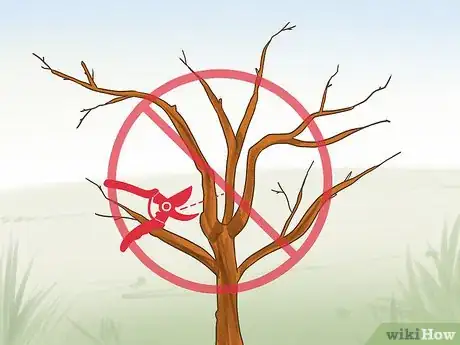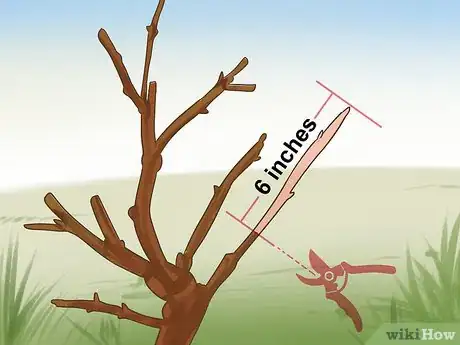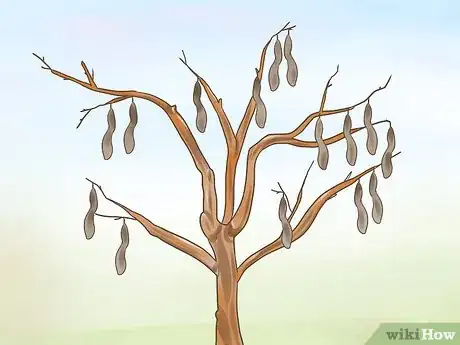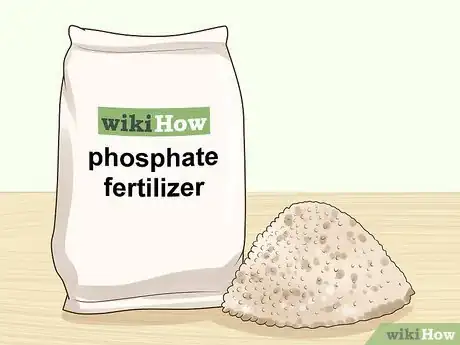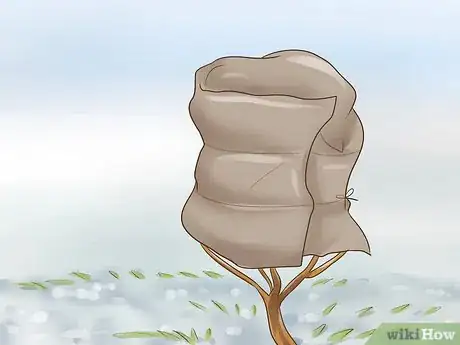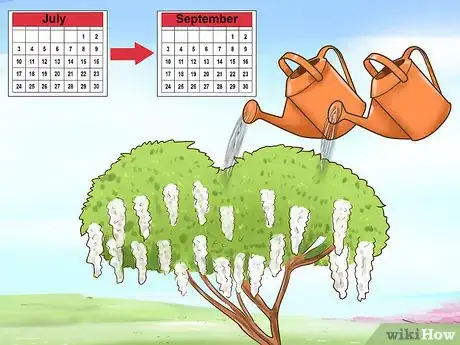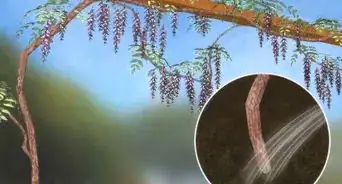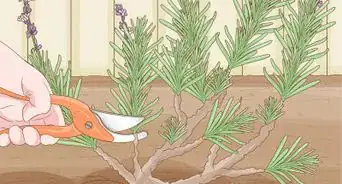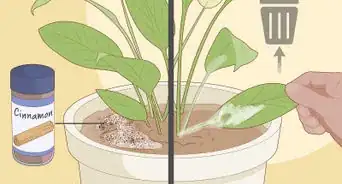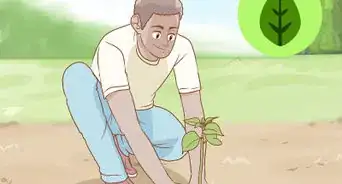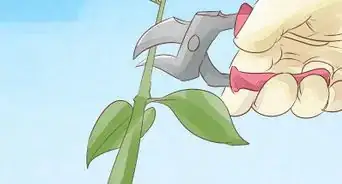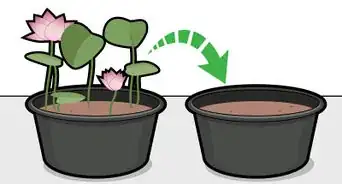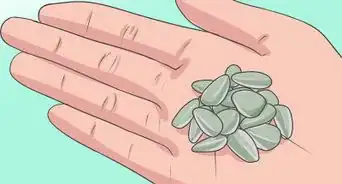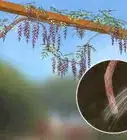This article was co-authored by Katie Gohmann. Katherine Gohmann is a Professional Gardener in Texas. She has been a home gardener and professional gardener since 2008.
There are 7 references cited in this article, which can be found at the bottom of the page.
wikiHow marks an article as reader-approved once it receives enough positive feedback. In this case, 94% of readers who voted found the article helpful, earning it our reader-approved status.
This article has been viewed 147,053 times.
Wisterias in bloom are a beautiful sight to behold. The lavender flowers cascade beautifully down the sides of buildings, pergolas, and bushes, which makes wisteria the envy of many gardeners. This robust vine can scale buildings with multiple stories and is strong enough to bring down structures that are supporting it if they are not sturdy enough. However, it can be a struggle to get the flowers to bloom. If you provide the ideal environment, add phosphorus to the soil, and do the necessary pruning, it will be possible to get your wisteria plant to bloom. Think about planting a native variety rather than the Chinese or Japanese varieties that can become invasive in many places.
Steps
Pruning Wisteria
-
1Prune in February and July. Winter pruning for wisteria is best done in February on a mild day. Then, pruning in the summer will cut back on the unruly growth and keep the plant in check. It is important to restrict the vegetative growth so that the flowering spurs are encouraged to blossom.
- Pruning in the winter is generally easier because the leaves have been shed and the framework of the plant is exposed.
- A good rule of thumb is to remove half of the prior year’s growth.[1]
-
2Prune the long shoots. The shoots are the new branches that have grown since the summer. They should be cut back so that there are only three to five buds per shoot. This will generally mean that three to four inches will be cut off each one.
- Pruning the branches will direct the plant’s energy to the flower. [2]
Advertisement -
3Avoid cutting the plant frame. While the shoots can be cut back, the main woody frame of the plant should not be cut. Maintaining a strong frame will ensure that the integrity of the plant remains intact.
-
4Cut the new growth back six inches. This creates better air circulation and allows the sunlight to reach the new growth. This improves the chances of the formation of flower buds.[3]
-
5Completely remove unnecessary shoots from the main framework. For older plants, it is necessary to remove branches that are run-down and branches that have grown over the structural features of buildings, such as windows and doors.
- This is known as a “hard prune” and it will stimulate strong growth, as this is a plant that can grow aggressively. To avoid this, avoid fertilizing in the first spring after the hard prune.[4]
-
6Leave the seedpods. Many gardeners find the seedpods of the wisteria plant to look decorative. You can leave the seedpods if you enjoy how they look; otherwise, it is acceptable to remove them.
Adding Phosphorus to the Soil
-
1Purchase a phosphate fertilizer. Using a fertilizer will encourage your wisteria to blossom. You can find phosphate fertilizer from an online retailer, or you can find it in a local or a big box store. You could also try using bone meal (in spring) and/or rock phosphate (in fall).[5]
-
2Add the phosphate fertilizer to the soil. You should only do this in the early spring, such as in April. When you have the fertilizer in your possession, read the instructions on the package and heed any warnings.
- If you have plenty of time to fertilize, use natural fertilizer and apply it to the surface of the soil. This method takes a long time to release nutrients into the soil.
- If you are short on time to fertilize, use a water-soluble fertilizer. This is a fluid solution that is dissolved in water and is sprayed onto the soil and the plants.
- Many times, when struggling to get a wisteria to bloom, too much nitrogen is the culprit. Adding phosphorus to the soil will balance the nitrogen already present in the soil and will encourage the wisteria to blossom.
-
3Add compost to the soil. Each spring, you should add compost to the soil around the wisteria. Apply a two-inch covering of mulch on top of the compost. This will retain moisture and deter weeds from growing around the plant.
- Wisteria grows best in fertile, moist, well-drained soil.[6]
- You can make your own compost or purchase compost from a gardening store.
- You can also make your own mulch.
Creating the Ideal Environment
-
1Plant wisteria in its ideal climate, if possible. Wisteria is best suited for the United States Department of Agriculture’s Hardiness Zones 5 through 9.[7] Although it can grow and adapt to just about any environment in the United States and other countries that do not have extreme climates, it will grow best in Zone 5, located along the United States’ Midwest and Central regions.[8]
- The USDA Plant Hardiness Zone Map is the standard used by gardeners to determine which plans are likely to thrive in certain locations.
- Zones 5-9 cover most of the continental United States, with the exception of upper midwest region, which covers, Minnesota, North and South Dakota, Montana, northern Michigan, and the northern portion of Wyoming.
-
2Ensure that wisteria gets plenty of sunlight. The various types of wisteria need a different amounts of sunlight to bloom. Generally speaking, wisteria grows best with sunlight all day long.
- Either check online by performing an internet search or check at a gardening store to find out how much sunlight is appropriate for the plant that you would like to bloom.
- Chinese wisteria can bloom in partial shade.
- Japanese wisteria requires full sunlight to bloom.
- American and Kentucky wisteria prefer full sun for blooms.
-
3Protect wisteria from frost. Newly planted wisteria does not do well in cold weather and the buds can be damaged by frost in the spring. If you live in an area with cold weather, you will need to plant wisteria somewhere that is sheltered so that the buds are protected from the frost.[9]
- You can shelter the plant by wrapping it in burlap during the winter and when frost is expected during the spring. Be sure to keep an eye on the weather and stay on top of any frost warnings.
- You can also plant wisteria so that it is protected by a structure, such as a screen, but this may not work if the species of wisteria requires a lot of sun.
-
4Give wisteria extra water between July and September. This is when the buds for next year are formed and the plant could benefit from some extra water.[10]
- Wisteria does not need to be watered often and should actually only be watered if you live in an area that receives less than an inch of rain per week. Otherwise, wisteria will receive enough water.[11]
Expert Q&A
Did you know you can get expert answers for this article?
Unlock expert answers by supporting wikiHow
-
QuestionI have a wisteria that is more than five years old and it has never bloomed. Is there any thing we can do to make it bloom or should we start over wiyh a new one?
 Katie GohmannKatherine Gohmann is a Professional Gardener in Texas. She has been a home gardener and professional gardener since 2008.
Katie GohmannKatherine Gohmann is a Professional Gardener in Texas. She has been a home gardener and professional gardener since 2008.
Professional Gardener Wisteria plants can sometimes take a while to begin blooming. You can help it along by making sure it has enough sun- without 6 hours of direct sun, the plant may never bloom. You also want to take the time to prune it. Pruning will usually encourage a lot of new growth, and wisteria blooms on its new growth!
Wisteria plants can sometimes take a while to begin blooming. You can help it along by making sure it has enough sun- without 6 hours of direct sun, the plant may never bloom. You also want to take the time to prune it. Pruning will usually encourage a lot of new growth, and wisteria blooms on its new growth! -
QuestionWhat are the pods that have formed?
 Katie GohmannKatherine Gohmann is a Professional Gardener in Texas. She has been a home gardener and professional gardener since 2008.
Katie GohmannKatherine Gohmann is a Professional Gardener in Texas. She has been a home gardener and professional gardener since 2008.
Professional Gardener
-
QuestionWhere are Wisteria bushes found?
 Community AnswerWisteria bushes are native to the Eastern United States and also to China, Japan, and Korea.
Community AnswerWisteria bushes are native to the Eastern United States and also to China, Japan, and Korea.
Warnings
- Do not use high-nitrogen fertilizer around wisterias, including lawn fertilizers, because the nitrogen will encourage leafy growth rather than flower blooms.⧼thumbs_response⧽
Things You'll Need
- Mature wisteria that has bloomed in the past
- Pruning shears
- Pruning saw
- Pail
- Shovel
- Twine
References
- ↑ https://www.almanac.com/plant/wisteria
- ↑ http://www.finegardening.com/pruning-and-training-wisteria
- ↑ https://www.rhs.org.uk/advice/profile?pid=242
- ↑ https://www.rhs.org.uk/advice/profile?pid=242
- ↑ http://www.almanac.com/plant/wisteria
- ↑ http://www.almanac.com/plant/wisteria
- ↑ http://homeguides.sfgate.com/conditions-planting-wisteria-22778.html
- ↑ http://planthardiness.ars.usda.gov/PHZMWeb/
- ↑ http://www.thompson-morgan.com/how-to-grow-wisteria
About This Article
If you want to help your wisterias bloom, prune the branches on a mild day in February, then again to tame unruly growth in July. Use garden shears to prune long shoots so there are only 3-5 buds per shoot, and aim to cut away about half of the previous year’s growth. However, avoid cutting the woody frame of the plant. In the early spring, around April, add phosphate fertilizer to the ground around the tree, then add compost to the soil, topped by a 2-inch layer of mulch. For tips from our horticulture expert on protecting your wisteria from frost, read on!
